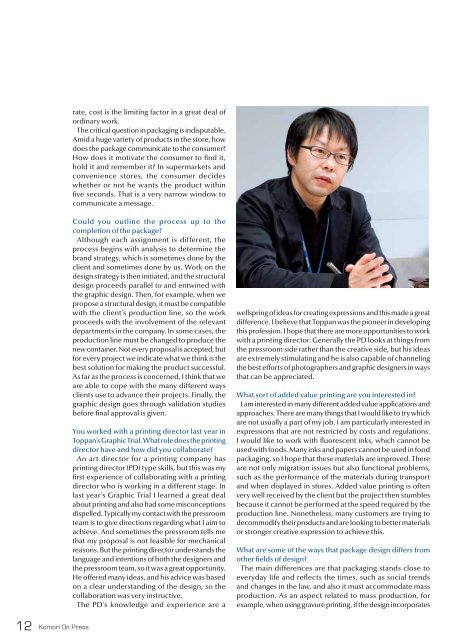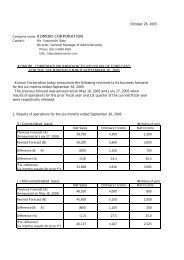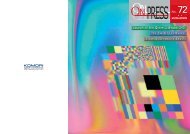You also want an ePaper? Increase the reach of your titles
YUMPU automatically turns print PDFs into web optimized ePapers that Google loves.
ate, cost is the limiting factor in a great deal of<br />
ordinary work.<br />
The critical question in packaging is indisputable.<br />
Amid a huge variety of products in the store, how<br />
does the package communicate to the consumer?<br />
How does it motivate the consumer to find it,<br />
hold it and remember it? In supermarkets and<br />
convenience stores, the consumer decides<br />
whether or not he wants the product within<br />
five seconds. That is a very narrow window to<br />
communicate a message.<br />
Could you outline the process up to the<br />
completion of the package?<br />
Although each assignment is different, the<br />
process begins with analysis to determine the<br />
brand strategy, which is sometimes done by the<br />
client and sometimes done by us. Work on the<br />
design strategy is then initiated, and the structural<br />
design proceeds parallel to and entwined with<br />
the graphic design. Then, for example, when we<br />
propose a structural design, it must be compatible<br />
with the client’s production line, so the work<br />
proceeds with the involvement of the relevant<br />
departments in the company. In some cases, the<br />
production line must be changed to produce the<br />
new container. Not every proposal is accepted, but<br />
for every project we indicate what we think is the<br />
best solution for making the product successful.<br />
As far as the process is concerned, I think that we<br />
are able to cope with the many different ways<br />
clients use to advance their projects. Finally, the<br />
graphic design goes through validation studies<br />
before final approval is given.<br />
You worked with a printing director last year in<br />
Toppan’s Graphic Trial. What role does the printing<br />
director have and how did you collaborate?<br />
An art director for a printing company has<br />
printing director (PD) type skills, but this was my<br />
first experience of collaborating with a printing<br />
director who is working in a different stage. In<br />
last year’s Graphic Trial I learned a great deal<br />
about printing and also had some misconceptions<br />
dispelled. Typically my contact with the pressroom<br />
team is to give directions regarding what I aim to<br />
achieve. And sometimes the pressroom tells me<br />
that my proposal is not feasible for mechanical<br />
reasons. But the printing director understands the<br />
language and intentions of both the designers and<br />
the pressroom team, so it was a great opportunity.<br />
He offered many ideas, and his advice was based<br />
on a clear understanding of the design, so the<br />
collaboration was very instructive.<br />
The PD’s knowledge and experience are a<br />
wellspring of ideas for creating expressions and this made a great<br />
difference. I believe that Toppan was the pioneer in developing<br />
this profession. I hope that there are more opportunities to work<br />
with a printing director. Generally the PD looks at things from<br />
the pressroom side rather than the creative side, but his ideas<br />
are extremely stimulating and he is also capable of channeling<br />
the best efforts of photographers and graphic designers in ways<br />
that can be appreciated.<br />
What sort of added value printing are you interested in?<br />
I am interested in many different added value applications and<br />
approaches. There are many things that I would like to try which<br />
are not usually a part of my job. I am particularly interested in<br />
expressions that are not restricted by costs and regulations.<br />
I would like to work with fluorescent inks, which cannot be<br />
used with foods. Many inks and papers cannot be used in food<br />
packaging, so I hope that these materials are improved. There<br />
are not only migration issues but also functional problems,<br />
such as the performance of the materials during transport<br />
and when displayed in stores. Added value printing is often<br />
very well received by the client but the project then stumbles<br />
because it cannot be performed at the speed required by the<br />
production line. Nonetheless, many customers are trying to<br />
decommodify their products and are looking to better materials<br />
or stronger creative expression to achieve this.<br />
What are some of the ways that package design differs from<br />
other fields of design?<br />
The main differences are that packaging stands close to<br />
everyday life and reflects the times, such as social trends<br />
and changes in the law, and also it must accommodate mass<br />
production. As an aspect related to mass production, for<br />
example, when using gravure printing, if the design incorporates<br />
12 <strong>Komori</strong> On Press




